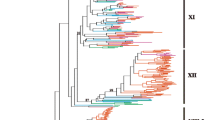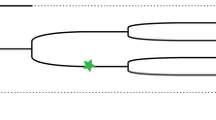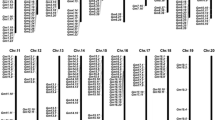Abstract
The leucine-rich repeat (LRR) receptor kinase (RLK) proteins constitute a large superfamily in the plant genome, and carry out key functions in a variety of biological pathways. In an effort to determine the evolutionary fate of members of a large gene family such as plant LRR RLK proteins we conducted in silico analysis using complete genome sequencing datasets, genome-wide transcriptome databases, and bioinformatics tools. A total of 292 and 165 LRR RLK genes were retrieved from the rice and Arabidopsis genomes, respectively, formed by diverse duplication events for gene expansion. The phylogenic analyses of the LRR RLK genes suggested combinations of LRR domains and RLK domains in the ancient plant genome prior to the divergence of rice and Arabidopsis, followed by massive independent expansions during speciation. The somewhat high frequencies (50–73%) of expressional divergence of members of duplicate gene pairs formed by whole/segmental genome duplication (W/SGD) and tandem duplication (TD) events of Arabidopsis and TD events of rice support the idea of their functional diversity for gene retention. By contrast, a relatively low degree (at least 20%) of members of rice LRR RLK gene pairs formed by W/SGD appear to be divergent in expression following the duplication event. At least 7 pairs of co-expressed gene clusters, including each of the tentative orthologous LRR RLK genes between rice and Arabidopsis, were enriched to an orthologous set between members of each of the pairs as compared to those of the random pairs, suggesting some degree of functional conservation of individual genes. These results may shed some light on the crucial functions of the plant LRR RLK genes with regard to a variety of biological processes.


Similar content being viewed by others
References
Adams KL, Cronn R, Percifield R, Wendel JF (2003) Genes duplicated by polyploidy show unequal contributions to the transcriptome and organ-specific reciprocal silencing. Proc Natl Acad Sci USA 100:4649–4654
Afoufa-Bastien D, Medici A, Jeauffre J, Coutos-Thevenot P, Lemoine R, Atanassova R, Laloi M (2010) The Vitis vinifera sugar transporter gene family: phylogenic overview and macroarray expression profiling. BMC Plant Biol 10:245
Apic G, Gough J, Teichmann SA (2001) Domain combinations in archaeal, eubacterial, and eukaryotic proteomes. J Mol Biol 310:311–325
Baumberger N, Doesseger B, Guyot R, Diet A, Parsons RL, Clark MA, Simmons MP, Bedinger P, Goff SA, Ringli C, Keller B (2003) Whole-genome comparison of leucine-rich repeat extensions in arabidopsis and rice. A conserved family of cell wall proteins from a vegetative and a reproductive clade. Plant Phyiol 131:1313–1326
Blanc G, Wolfe KH (2004) Functional divergence of duplicated genes formed by polyploidy during Arabidopsis evolution. Plant Cell 16:1679–1691
Blanchette M, Tompa M (2003) Foot printer: a program designed for phylogenetic footprinting. Nucleic Acids Res 31:3840–3842
Ceulemans H, De Maeyer M, Stalmans W, Bollen M (1999) A capping domain for LRR protein interaction modules. FEBS Lett 456:349–351
Chapman BA, Bowers JE, Feltus FA, Paterson AH (2006) Buffering of crucial functions by paleologous duplicate genes may contribute cyclicality to angiosperm genome duplication. Proc Natl Acad Sci 103:2730–2735
Fincato P, Moschou PN, Spedaletti V, Tavazza R, Angelini R, Federico R, Roubelakis-Angelakis KA, Tavladoraki P (2011) Functional diversity inside the Arabidopsis polyamine oxidase gene family. J Exp Bot 62:1155–1168
Force A, Lynch M, Pickett FB, Amores A, Yan YL, Postlethwait J (1999) Preservation of duplicate genes by complementary, degenerative mutations. Genetics 151:1531–1545
Gou X, He K, Yang H, Yuan T, Lin H, Clouse SD, Li J (2010) Genome-wide cloning and sequence analysis of leucine-rich repeat receptor-like protein kinase genes in Arabidopsis thaliana. BMC Genomics 11:19
Han JH, Batey S, Nickson AA, Teichmann SA, Clarke J (2007) The folding and evolution of multidomain proteins. Nat Rev Mol Cell Biol 8:319–330
Innan H, Kondrashov F (2010) The evolution of gene duplications: classifying and distinguishing between models. Nat Rev Genet 11:97–108
Jain M, Nijhawan A, Arora R, Agarwal P, Ray S, Sharma P, Kapoor S, Tyagi AK, Khurana J (2007) F-box proteins in rice. Genome-wide analysis, classification, temporal and spatial gene expression during panicle and seed development, and regulation by light and abiotic stress. Plant Physiol 143:1467–1483
Jang CS, Yim WC, Moon J-C, Jung JH, Lee TG, Lim SD, Cho SH, Lee KK, Kim K, Seo YW, Lee B-M (2008) Evolution of non-specific lipid transfer protein (nsLTP) genes in the Poaceae family: their duplication and diversity. Mol Genet Genomics 279:481–497
Knaap E, Song W-Y, Ruan D-L, Sauter M, Ronald PC, Kende H (1999) Expression of a gibberellin-induced leucine-rich repeat receptor-like protein kinase in deepwater rice and its interaction with kinase-associated protein phosphatase. Plant Physiol 120:559–569
Kobe B, Kajava AV (2001) Theleucine-rich repeat as a protein recognition motif. Curr Opin Struc Biol 22:724–732
Larkin MA, Blackshields G, Brown NP, Chenna R, McGettigan PA, McWilliam H, Valentin F, Wallace IM, Wilm A, Lopez R (2007) Clustal W and Clustal X version 2.0. Bioinformatics 23:2947–2948
Lim SD, Yim WC, Moon JC, Kim DS, Lee B-M, Jang CS (2010) A gene family encoding RING finger proteins in rice: their expansion, expression diversity, and co-expressed genes. Plant Mol Biol 72:369–380
Lorenzo de L, Merchan F, Laporte P, Thompson R, Clarke J, Sousa C, Crespi M (2009) A novel plant leucine-rich repeat receptor kinase regulates the response of Medicago truncatula roots to salt stress. Plant Cell 21:668–680
Moore RC, Purugganan MD (2005) The evolutionary dynamics of plant duplicate genes. Curr Opin Plant Biol 8:122–128
Nacher JC, Hayashida M, Akutus T (2010) The role of internal duplication in the evolution of multi-domain proteins. Biosystems 101:127–135
Nei M, Gojobori T (1986) Simple methods for estimating the numbers of synonymous and nonsynonymous nucleotide substitutions. Mol Biol Evol 3:418–426
Newbury HJ, Paterson AH (2003) Genomic colinearity and its application in crop plant improvement. In: Newbury HJ (ed) Plant molecular breeding. Blackwell, pp 60–81
Nikhawan A, Jain M, Tyagi AK, Khurana JP (2008) Genomic survey and gene expression analysis of the basic leucine zipper transcription factor family in rice. Plant Physiol 146:333–350
Oh M-H, Wang X, Wu X, Zhao Y, Clouse SD, Huber SC (2010) Autophosphorylation of Tyr-610 in the receptor kinase BAK1 plays a role in brassinosteroid signaling and basal defense gene expression. Proc Natl Acad Sci 107:17827–17832
Ohno S (1970) Evolution by gene duplication. Springer, New York
Osakabe Y, Maruyama K, Seki M, Satou M, Shinozaki K, Yamaguchi-Shinozaki K (2005) Leucine-rich repeat receptor-like kinase 1 is a key membrane-bound regulator of abscisic acid early signaling in arabidopsis. Plant Cell 17:1105–1119
Pitorre D, Llauro C, Jobet E, Guilleminot J, Brizard J-P, Delseny M, Lasserre E (2010) RLK7, a leucine-rich repeat receptor-like kinase, is required for proper germination speed and tolerance to oxidative stress in Arabidopsis thaliana. Planta 232:1339–1353
Saitou N, Nei M (1987) The neighbor-joining method: a new method for reconstructing phylogenetic trees. Mol Biol Evol 4:406–425
Shiu SH, Bleecker AB (2001) Receptor-like kinases from arabidopsis form a monophyletic gene family related to animal receptor kinases. Proc Natl Acad Sci 98:10763–10768
Shiu SH, Bleecker AB (2003) Expansion of the receptor-like kinase/Pelle gene family and receptor-like proteins in arabidopsis. Plant Physiol 132:530–543
Swanson WJ (2003) Adaptive evolution of genes and gene families. Curr Opinion Genet Devlop 13:617–622
Torii KU (2000) Receptor kinase activation and signal transduction in plants: an emerging picture. Curr Opin Plant Biol 3:361–367
Verrelli BC, Lewis CM Jr, Stone AC, Perry GH (2008) Different selective pressures shape the molecular evolution of color vision in chimpanzee and human populations. Mol Biol Evol 25:2734–2735
Vogel C, Bashton M, Kerrison ND, Chothia C, Teichmann SA (2004) Structure, function, and evolution of mutidomain proteins. Curr Opin Struc Biol 14:208–216
Walker JC, Zhang R (1990) Relationship of a putative receptor protein kinase from maize to the S-locus glycoproteins of Brassica. Nature 345:743–746
Wang HW, Kwon HJ, Yim WC, Lim SD, Moon J-C, Lee B-M, Seo YW, Kim W, Jang CS (2010) Expressional diversity of wheat nsLTP genes: evidence of sun functionalization via cis-regulatory divergence. Genetica 138:843–852
Yang Z (2007) PAML 4: phylogenetic analysis by maximum likelihood. Mol Biol Evol 24:1586
Yim WC, Lee B-M, Jang CS (2009) Expression diversity and evolutionary dynamics of rice duplicate genes. Mol Genet Genomics 281:483–493
Zhang X (1998) Leucine-rich repeat receptor-like kinases in plants. Plant MolBiol 16:301–311
Zhang S, Chen C, Li L, Meng L, Singh J, Jiang N, Deng X-W, He Z-H, Lemaux PG (2005) Evolutionary expansion, gene structure, and expression of the rice wall-associated kinase gene family. Plant Phyiol 139:1107–1124
Zimmermann P, Henning L, Gruissem W (2005) Gene-expression analysis and network discovery using Genevestigator. Trends Plant Sci 10:407–409
Acknowledgments
This research was supported by a grant from the Korea Atomic Energy Research Institute (KAERI) and a grant from the Nuclear R&D program through the National Research Foundation of Korea funded by the Ministry of Education, Science, and Technology (MEST), Republic of Korea.
Author information
Authors and Affiliations
Corresponding author
Additional information
Sun-Goo Hwang and Dong Sub Kim contributed equally to this report.
Electronic supplementary material
Below is the link to the electronic supplementary material.
Rights and permissions
About this article
Cite this article
Hwang, SG., Kim, D.S. & Jang, C.S. Comparative analysis of evolutionary dynamics of genes encoding leucine-rich repeat receptor-like kinase between rice and Arabidopsis. Genetica 139, 1023–1032 (2011). https://doi.org/10.1007/s10709-011-9604-y
Received:
Accepted:
Published:
Issue Date:
DOI: https://doi.org/10.1007/s10709-011-9604-y




